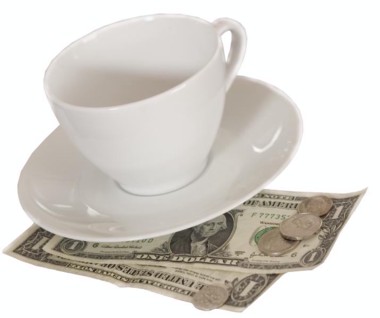Discussions of servers’ wages lead to debates about tipping, and those debates are passionate on both sides. How hardhearted do you have to be not to tip a person who’s only getting $2.13 ($2.63 in Massachusetts) to reel off the list of specials, take your order, remember to put your salad dressing on the side, bring you hot tea without spilling it down your back, run for extra napkins when the baby spits up, and take a picture of your smiling family group?
But there’s a downside: tipping creep. Once we tipped 10 percent, with a little extra for the valiant waitress who refilled our coffee half a dozen times or swept up the pieces if someone dropped a glass on the floor. Later it was 15 percent; now in many places our meal costs 120 percent of its stated price. Once only the person who brought your plate to the table and cleared up after you, enabling you to come and go with the poise of a guest, got a tip; now all sorts of folks expect it, including counter people in places where you take your chow and silverware to the table and do your own bussing.
The reasons most servers don’t want tips to go the way of the vinyl record is obvious: in the only world they know, base pay is abysmal, and they don’t want to lose the chance for the expected or unexpected big-buck gratuity.
But the conventional wisdom about tipping—for example, that it rewards good service—is proven by many studies to be rife with misconceptions. Research has shown that tip size is related less to the quality of the server’s performance than to looks; willingness to flirt or otherwise blandish customers; race (servers of color often get lower tips than white servers, while, conversely, diners of color get poorer service); gender (women get higher tips than men); and possibly other intangibles. A study from France claims that women wearing red get more lavish tips than servers wearing other colors.
A popular New York restaurant, Sushi Yasuda, has created a stir by announcing that its waitpeople will no longer accept tips. Instead they are now receiving salaries and benefits. Granted, Yasuda is a high-end place where one roll can set you back $25 and the owners can afford to pay workers a living wage. But Daisy Chung of Restaurant Opportunities Center of New York says her group would like for such practices to become the new normal.
“We definitely feel there shouldn’t be a separate system where tip workers rely on tips to subsidize their wages,” Chung told Business Insider. “Workers should be fully compensated.”
A less radical solution to the problems of tipping is including a gratuity in the bill, a familiar practice that lets customers off the hook for computing the tip but ensures that servers will get something, even if they’re not wearing red.•



